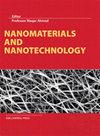Grewia tenax 介导的银纳米粒子作为高效抗菌剂和抗真菌剂
IF 3.3
3区 材料科学
Q2 MATERIALS SCIENCE, MULTIDISCIPLINARY
引用次数: 0
摘要
纳米粒子作为抗微生物感染的可能药物分子,已经引起了人们的极大兴趣。通过探索植物的还原潜力和封盖活性合成的金属纳米粒子具有显著的抗菌活性。合成过程中不使用有害化学物质,也不会产生有毒废品。因此,本研究的重点是研究利用天麻叶提取物生物合成的银纳米粒子作为抗菌、抗生物膜和抗真菌治疗剂的功效。银纳米粒子(GTAgNPs)是在 2.5 mM AgNO3 和 1 :10% 的提取物,在 37°C 温度下持续搅拌。表征采用了紫外可见光谱、DLS、扫描电镜、ZETA电位和傅立叶变换红外光谱。通过抑菌区、MIC 和 MBC 分析了 GTAgNPs 对革兰氏(+)蜡样芽孢杆菌和金黄色葡萄球菌以及革兰氏(-)大肠杆菌和绿脓杆菌的抗菌活性。还观察了银纳米粒子对这些细菌生物膜形成的抑制作用。然后,通过观察真菌生长抑制作用,评估了这些纳米粒子对白色念珠菌和黑曲霉的潜在抗真菌活性。通过扫描电子显微镜研究了 GTAgNPs 抗菌活性的可能机制,结果表明 GTAgNPs 处理过的微生物细胞表面会形成明显的孔隙,导致微生物细胞死亡。所有这些研究得出结论,GTAgNPs 具有强大的抗菌潜力,可用作抗菌治疗剂。本文章由计算机程序翻译,如有差异,请以英文原文为准。
Grewia tenax-Mediated Silver Nanoparticles as Efficient Antibacterial and Antifungal Agents
Nanoparticles have gained immense interest as probable drug molecules against microbial infections. Metal nanoparticles synthesized via exploring the reduction potential and capping activity of plants were found to have remarkable antimicrobial activity. The synthesis was conducted without hazardous chemicals and generation of toxic waste products. The focus of the study was, therefore, to investigate the efficacy of silver nanoparticles biosynthesized using Grewia tenax leaf extract as an antibacterial, antibiofilm, and antifungal therapeutic agent. The silver nanoparticles (GTAgNPs) were synthesized using optimized conditions of 2.5 mM AgNO3 and 1 : 10 ratio of 10% extract at 37°C on continuous stirring. The characterization was done by UV-visible spectroscopy, DLS, SEM, zeta potential, and FTIR. The antibacterial activity of GTAgNPs against both Gram (+) Bacillus cereus and Staphylococcus aureus and Gram (−) Escherichia coli and Pseudomonas aeruginosa bacteria via zone of inhibition, MIC, and MBC was analysed. The inhibitory effect of silver nanoparticles on biofilm formation was also observed against these bacteria. These nanoparticles were then evaluated for their potential antifungal activity against Candida albicans and Aspergillus niger by observing fungal growth inhibition. The probable mechanism of antimicrobial activity by GTAgNPs was studied by scanning electron microscopy which showed the significant formation of pores on the cell surface in GTAgNPs-treated microbial cells, leading to the death of the microbial cell. All these studies concluded that GTAgNPs possess the potent antimicrobial potential and can be employed as antimicrobial therapeutic agents.
求助全文
通过发布文献求助,成功后即可免费获取论文全文。
去求助
来源期刊

Nanomaterials and Nanotechnology
NANOSCIENCE & NANOTECHNOLOGY-MATERIALS SCIENCE, MULTIDISCIPLINARY
CiteScore
7.20
自引率
21.60%
发文量
13
审稿时长
15 weeks
期刊介绍:
Nanomaterials and Nanotechnology is a JCR ranked, peer-reviewed open access journal addressed to a cross-disciplinary readership including scientists, researchers and professionals in both academia and industry with an interest in nanoscience and nanotechnology. The scope comprises (but is not limited to) the fundamental aspects and applications of nanoscience and nanotechnology
 求助内容:
求助内容: 应助结果提醒方式:
应助结果提醒方式:


